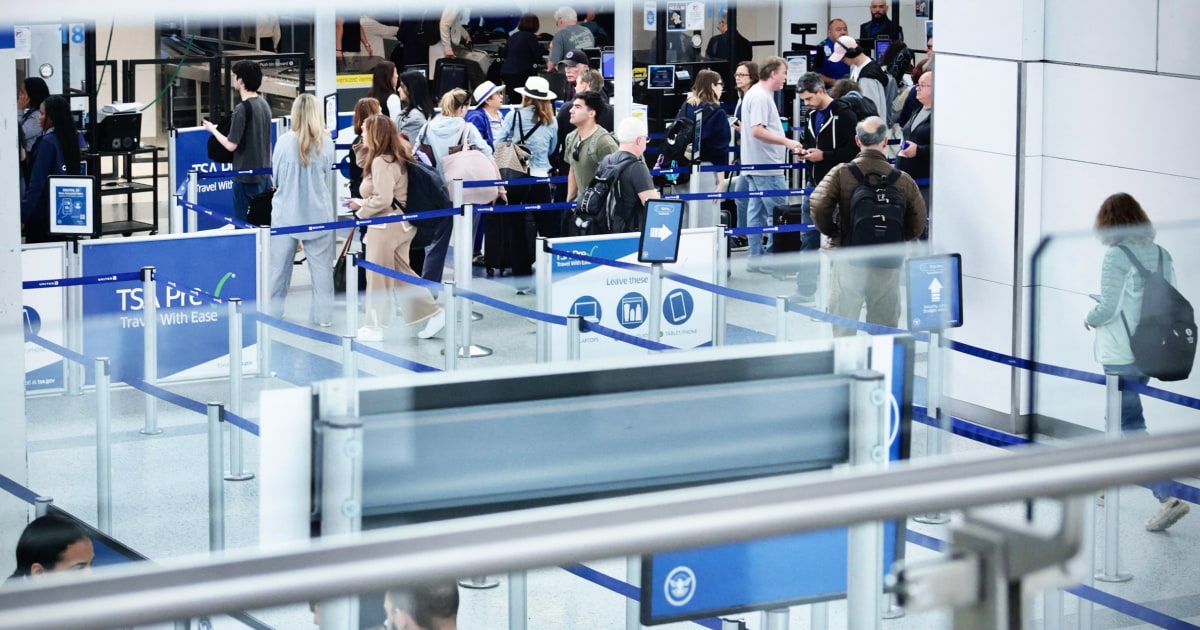For some travelers, Newark Liberty International Airport has become a no-fly zone.
With passengers spooked by reports of harried air traffic controllers’ losing radio and radar contact with planes and dismayed by the resulting massive flight delays, the average daily number of travelers flying out of Newark, New Jersey, has dropped by as much as 20% compared with this time last year, from around 72,983 during the second week of May 2024 to 58,496 last week, according to Transportation Security Administration data reviewed by NBC News.
Meanwhile, New York’s LaGuardia Airport experienced a 16% increase in the average daily number of travelers during the same period, from 36,367 in 2024 to 42,037 this year, the data shows.
And New York City’s John F. Kennedy International Airport has had a slight increase in the average number of daily travelers, from 96,392 in 2024 to 97,061 this year in the second week of May, according to the data.
The Federal Aviation Administration predicts higher-than-usual volume of flights for the Memorial Day weekend, with a peak of about 54,000 flights Thursday.
“We’re expecting flight numbers to grow week by week throughout the summer, with the peak at the end of July and six more 54,000+ flight days before the end of August,” the FAA said in a statement. “Thursdays will be the busiest day of the week.”
But at Newark, the FAA has proposed reducing the number of arrivals and departures after air traffic communication issues caused controllers to lose radio and radar contact with the planes they were guiding for 90 seconds on April 28.
There is “a structure of how many flights can leave per hour. We have a delayed flight schedule of takeoffs,” Transportation Secretary Sean Duffy said, Reuters reported Tuesday. “You are going to see a reduction.”
That reduction came by way of an interim order that takes effect Tuesday: Until construction of Runway 4-Left/22-Right is complete, the maximum hourly rate will be 28 arrivals and 28 departures, the FAA said. Daily construction will end June 15 but will continue on Saturdays through the end of the year.
Outside of the construction period, 34 hourly arrivals and departures will be allowed until Oct. 25.
“Our goal is to relieve the substantial inconvenience to the traveling public from excessive flight delays due to construction, staffing challenges, and recent equipment issues, which magnify as they spread through the National Airspace System,” acting FAA Administrator Chris Rocheleau said in a statement.
The agency added that arrival and departure limits could be adjusted higher or lower, depending on conditions.
United Airlines, which has a hub at Newark, would be the most affected, Duffy said. “They’re the biggest player at Newark,” he said.
United Airlines said in a statement that “reducing the number of flights scheduled at Newark will help ensure that we can safely and reliably operate the flights that remain on the schedule.”
Earlier this month, it voluntarily cut 35 round-trip flights per day from Newark, where, in addition to a shortage of controllers, ongoing runway construction has contributed to flight delays.
“We are confident that the decisive steps taken by Sec. Duffy, including his leadership on matching the airport’s capacity to its operational limitations, will have it back operating reliably for the benefit of our customers,” United said.
Since Duffy announced last week that the FAA and the major airlines were talking about reducing the number of flights in and out of Newark, the percentage of flight cancellations has dropped significantly.
For most of last week, Newark’s share of nationwide flight cancellations had been hovering between 35% and 60%, according to FlightAware data. But on Friday, the number of cancellations was at 15%, and it dropped to 9% on Saturday.
While Duffy has said no planes were ever in any danger of colliding or crashing when the controllers’ radio and radar went down on April 28, several of the controllers working that day went on trauma leave, further reducing the already depleted ranks of controllers available to work the crowded skies over New Jersey.
There should be 38 certified controllers serving Newark, the FAA has said. Currently, there are only 22.
Mishaps continue to plague the aging system. The controllers for Newark, who are actually based in Philadelphia, lost radio frequencies with the planes they guide for 2 seconds at around 11:35 a.m. Monday.
No planes were in danger of colliding, and the FAA said it is investigating.
Nick Daniels, president of the National Air Traffic Controllers Association, said Tuesday in an interview that “it’s absolutely safe to fly.”
But when he was asked whether it is likely to be a summer of travel woes at Newark airport, Daniels said that “I think the focus has to be on it getting better soon” and that the shortage of air traffic controllers is a nationwide problem.
“Right now we operate a system with 10,800 hard-working American men and women,” Daniels said. “But we should be having 14,663 staff that very system.”
Many of the controllers are working six-day weeks and 10-hour shifts, he said.
“Morale is low right now when you’re dealing with the pressure and scrutiny that’s going on in the aviation system right now, with low staffing in every one of your facilities,” Daniels said.
Last month, Duffy said he expected the FAA to meet its goal of graduating 2,000 new air traffic controllers this year but warned the chronic shortage of controllers would take years to fix.
But he has also gotten bipartisan pushback from lawmakers who noted that the April snafu happened not long after the Trump administration fired hundreds of FAA workers, including maintenance mechanics, aeronautical information staff members and environmental protection specialists, in its effort to shrink the federal government.













